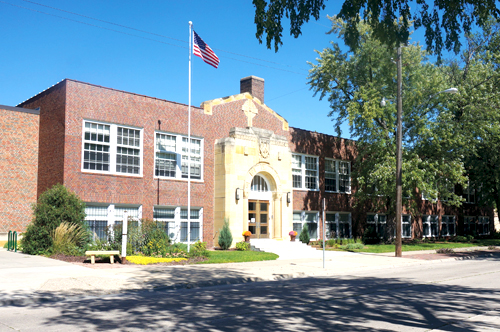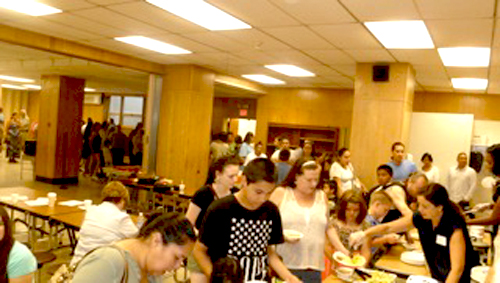 On Aug. 25, a sunny morning in
On Aug. 25, a sunny morning in
Minneapolis, Bdote Learning Center opened. The historic beginning
marked the end of six years of planning and developing as –
children entered the school to study what all children learn in
Kindergarten to third grade – except that they will be learning in
the Ojibwe and Dakota languages. These languages, now only spoken by
a few, are reflected throughout Minnesota in place names and the very
names of the city and state where the school is located.
Mike Huerth is Bdote’s first
principal. “One thing that attracted me to this school is my love
of the Ojibwe language. I have wanted to learn the language since my
high school days but somehow, throughout my career in education, I
never seemed to have had the time to learn my mother tongue,” he
said.
The children swarmed around the
principal and he returned their affection with a pat or some softly
spoken instructions. He remembered the experiences of children who
went to boarding school. Unlike then – when English was forced on
children – Ojibwe and Dakota are spoken in a friendly environment.
The first day of school was expected
to be somewhat difficult for most of the children. There are a very
few who come from day care and pre-school experiences where they did
learn Ojibwe and Dakota. For these children, it is easy to converse
with the teachers and as time goes by they will also help the other
children learn through the natural propensity for children to share
language, no matter which one it is.
On Aug. 24, Huerth and the teachers
and some of the board members gathered for two important ceremonies:
a pipe ceremony conducted by Bdote’s Curriculum Coordinator Deidre
WhiteMan and an Ojibwe water ceremony, led by second and third grade
teacher Lisa Bellanger. Those ceremonies marked the end of a six-year
journey from when the idea of a language immersion school was
proposed to moving into St. Albert’s at 3216 E. 29th Street in
South Minneapolis. The many words of encouragement and hard
determination pushed the school forward through what seemed to the
Bdote board of directors, nearly impossible odds.
Huerth looks forward to a successful
year. The school has a capacity of 104 for the 2014-15 school year
and over 90 students are enrolled. Full enrollment is likely once
families make their choices in the next few days.
Teachers include Beth Brown (Dakota
Kindergarten); Jolene New Holy (Dakota first, second and third
grades); Jarydd Boston (Dakota first, second and third grades);
Persia Erdrich and Katie Carlson (Ojibwe Kindergarten); David Butler
(Ojibwe first grade); Lisa Bellanger (Ojibwe second and third grade).
They are joined by Liz Cates (music and art) and Emmy Her Many Horses
(Special Education).
WhiteMan worked with artists and
curriculum developers for several months to prepare materials for the
students. The art and written materials will help students better
understand spelling and grammar in Ojibwe and Dakota and give them
content for lessons.
Elaine Salinas, Chair of the Bdote
board knows the story of the development of the school. “Beginning
in 2008,” she said, “a group of Indian educators, Native language
activists and community members began to discuss a new kind of school
for Indian children. We envisioned a school that would honor and
incorporate the cultures and languages indigenous to Minnesota, as
well as a school that would develop and nurture the genius of Indian
children – a school unlike any school that had ever existed.”
The Minneapolis Public Schools agreed
with this vision and it was looking for a school to replace Oh Day
Aki Charter School that they had closed earlier that year due to
mismanagement.
Over the next six years, Salinas said
the group met regularly to formulate a vision and plan for the
school. “We originally pursued the idea of a ‘self-governed’ school
only to learn one year into the process that MPS would not
financially support such a start-up as originally promised. We then
decided to pursue a charter with the belief that the chartering
process would enable us to create the kind of school that would not
be constrained by the restrictions and requirements of regular public
schools.”
Salinas and her group pursued several
authorizers for our charter school and finally found an understanding
and supportive single purpose authorizer, Innovative Quality Schools
– the first single purpose charter school authorizer approved by
the Minnesota Department of Education. They shared a vision for a
school that would not only honor indigenous languages but allow it to
deliver academic instruction through the languages.
The group sought approval for a
charter school affidavit by the state education department, which
occurred after several months and many discussions. “The
misunderstanding that MDE initially held was that Bdote would be a
school that would serve Indian children exclusively and therefore be
a ‘race specific school.’ We clarified that Bdote was not
intended to serve only Indian children and would be open to any child
interested in learning the Ojibwe and Dakota languages. We also
clarified that according to a huge body of case law, Indians are
considered political groups, not racial groups, by the federal
government based on our historic government-to-government
relationship,” Salinas said.
Department of Education approved the charter for Bdote Learning
Center in 2013. Since that time, the Bdote board worked to shape the
curriculum, hire the teachers, find adequate facilities for the
school and identify the school’s leader. A new door opened for
Minneapolis children and their families into a school where
Minnesota’s native languages will be heard and learned in every
day. As the school progresses and a grade is added each year, fluency
in the Ojibwe and Dakota languages will be heard among students
throughout the school, reversing out a dark past of forced English
language learning based on corporal punishment.
Top photo: Bdote Learning Center, hosted at St. Albert the Great, features total immersion in Dakota and Ojibwe. Curriculum will be adapted, written and taught in both languages by licensed teachers with guidance from lders. English is introduced as a language art in third grade. (Photo by Alfred Walking Bull.)
Bottom photo: Families of the first 90 enrolled students share a meal. (Photo by Lloyd C. Wittstock)







